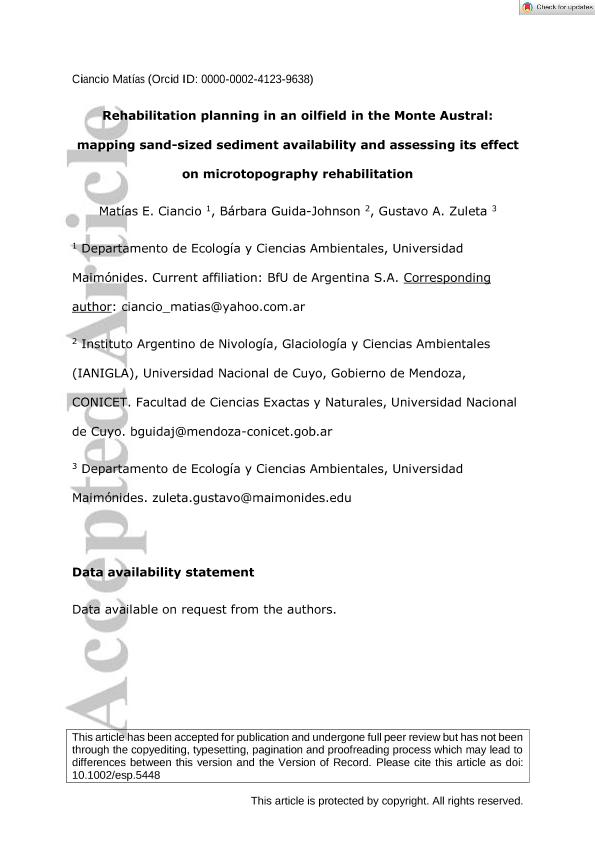Artículo
Rehabilitation planning in an oilfield in the Monte Austral: Mapping sand-sized sediment availability and assessing its effect on microtopography rehabilitation
Fecha de publicación:
10/2022
Editorial:
John Wiley & Sons Ltd
Revista:
Earth Surface Processes And Landforms
ISSN:
0197-9337
Idioma:
Inglés
Tipo de recurso:
Artículo publicado
Clasificación temática:
Resumen
In drylands, the microtopography is formed by mound-shaped dunes of eolian deposition that occur around shrubs or other vegetation in clumps. These mounds are characteristic of the Monte Austral, which covers 20% of Argentina (approximately 50 million ha), has a strong water deficit and is subjected to land degradation by the oil industry. Considering the biogeomorphological approach, oilfield rehabilitation should begin with regeneration of the mounds as they provide safe sites for vegetation. Since rehabilitation success may be influenced by sand-sized sediment availability, we addressed two objectives: mapping the sediment availability in an oilfield and evaluating its effect on microtopography rehabilitation. We used a Sentinel-2 MSI scene and assessed three approaches to map the sediments: two expressions of the Normalized Difference Sand Index and the feature Brightness of the Tasselled Cap Transformation. We validated the three maps using a geomorphological map. Two maps showed the highest agreement with the geomorphological map and errors were associated with the detection of bright lithified or cohesive material not available for sediment transportation. Then, we evaluated the effect of sediments on microtopography rehabilitation. We compared the morphometric traits of mounds (height, maximum and minimum length) located in areas of low and high sediment availability, in both natural and scarified areas. We considered the time since scarification was applied (8–13, 4–8, or <4 years ago). The mounds in the natural areas were larger than the mounds in the scarified areas, so complete microtopography rehabilitation is not achieved 13 years after scarification. The mounds in high-sediment-availability areas were different from the initial condition 4 years after scarification, whereas differences took 8 years to become evident with low sediment availability. Sediment availability must be considered when designing rehabilitation techniques to ensure the success and sustainability of the project. Our results have implications for the development of a biogeomorphological model to guide rehabilitation planning.
Archivos asociados
Licencia
Identificadores
Colecciones
Articulos(IANIGLA)
Articulos de INST. ARG. DE NIVOLOGIA, GLACIOLOGIA Y CS. AMBIENT
Articulos de INST. ARG. DE NIVOLOGIA, GLACIOLOGIA Y CS. AMBIENT
Citación
Ciancio, Matías Ezequiel; Guida Johnson, Bárbara; Zuleta, Gustavo Adolfo; Rehabilitation planning in an oilfield in the Monte Austral: Mapping sand-sized sediment availability and assessing its effect on microtopography rehabilitation; John Wiley & Sons Ltd; Earth Surface Processes And Landforms; 47; 13; 10-2022; 3133-3146
Compartir
Altmétricas




